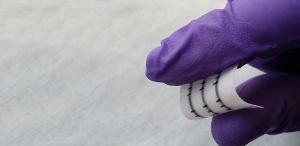Nov 9 2017
Scientists have achieved the successful integration of stretchable, washable, and breathable electronic circuits into fabric. This achievement paves the way for innovative probabilities in the fields of wearable electronics and smart textiles. The circuits were developed using safe, inexpensive, and environment-friendly inks, and they were printed by adopting traditional inkjet printing methods.
 Sample circuit printed on fabric. CREDIT: Felice Torrisi.
Sample circuit printed on fabric. CREDIT: Felice Torrisi.
University of Cambridge worked with collaborators from Italy and China to show the way graphene (a two-dimensional form of carbon) can be printed directly onto fabric to develop integrated electronic circuits which can be comfortably worn and with the ability to withstand nearly 20 cycles in a usual washing machine.
The innovative fabric electronic devices are developed by sustainable, inexpensive, and scalable inkjet printing of inks formed of graphene and similar two-dimensional materials. Standard processing methods are adopted to develop these devices. The outcomes of the study have been reported in a paper published in the Nature Communications journal.
The researchers used prior research on the synthesis of graphene inks for printed electronics to design inks with low boiling point, which were printed directly onto polyester fabric. Moreover, they also discovered that changes to the fabric’s roughness enhanced the performance of the printed devices. The adaptability of this method enabled the team to develop single transistors as well as all-printed integrated electronic circuits integrating passive and active components.
Majority of the wearable electronic devices accessible in the market at present are dependent on rigid electronic components integrated with rubber, plastic, or textiles. In many instances, such devices have restricted compatibility with the skin, are not comfortable to wear as they are non-breathable, and may get damaged while being washed.
“Other inks for printed electronics normally require toxic solvents and are not suitable to be worn, whereas our inks are both cheap, safe and environmentally-friendly, and can be combined to create electronic circuits by simply printing different two-dimensional materials on the fabric,” stated Dr Felice Torrisi from the Cambridge Graphene Centre, who is the senior author of the paper.
Digital textile printing has been around for decades to print simple colourants on textiles, but our result demonstrates for the first time that such technology can also be used to print the entire electronic integrated circuits on textiles, although we demonstrated very simple integrated circuits, our process is scalable and there are no fundamental obstacles to the technological development of wearable electronic devices both in terms of their complexity and performance.
Professor Roman Sordan from Politecnico di Milano, co-author of the paper
“The printed components are flexible, washable and require low power, essential requirements for applications in wearable electronics,” stated Tian Carey, a PhD student and the first author of the paper.
The study paves the way for numerous commercial probabilities for two-dimensional material inks, such as wearable computing and fashion, personal health and well-being technology, military garments, wearable energy harvesting and storage.
Dr Felice Torrisi from the Cambridge Graphene Centre commented:
"Turning textile fibres into functional electronic components can open to an entirely new set of applications from healthcare and wellbeing to the Internet of Things, thanks to nanotechnology, in the future our clothes could incorporate these textile-based electronics, such as displays or sensors and become interactive."
There is considerable focus on using graphene and other associated 2D material (GRM) inks to develop electronic devices and components combined in innovative textiles and fabrics in the smart textiles industry. The teams from the Cambridge Graphene Centre and Politecnico di Milano are also part of the Graphene Flagship, an EC-funded, pan-European project committed to ensure commercial prospects of graphene and GRM technologies.
Grants from the Graphene Flagship, the European Research Council’s Synergy Grant, The Engineering and Physical Science Research Council, The Newton Trust, the International Research Fellowship of the National Natural Science Foundation of China, and the Ministry of Science and Technology of China supported the study. Cambridge Enterprise, the University’s commercialization arm, has been commercializing the technology.